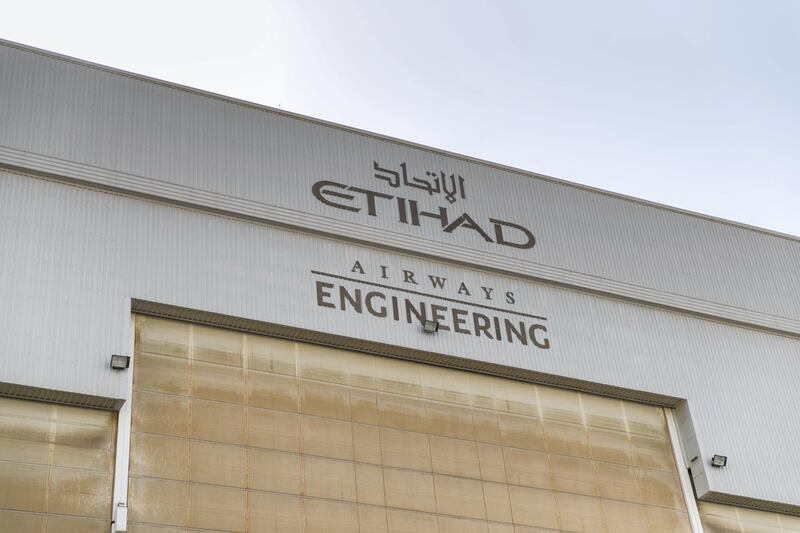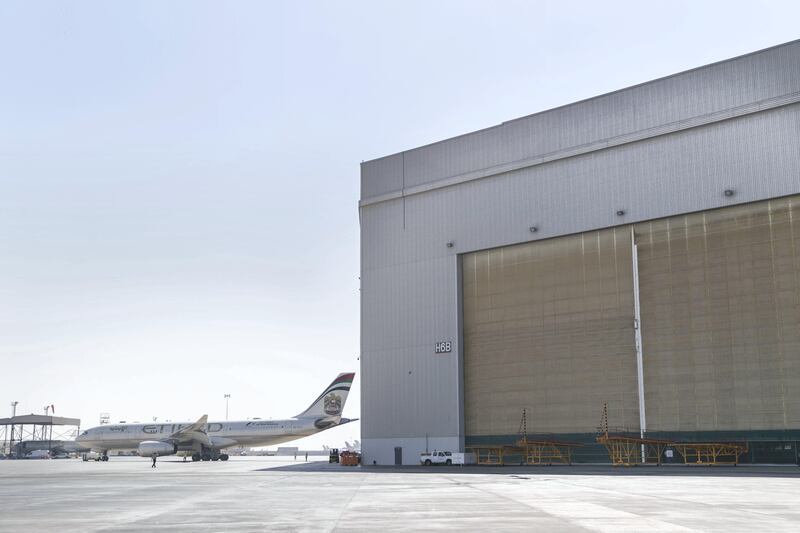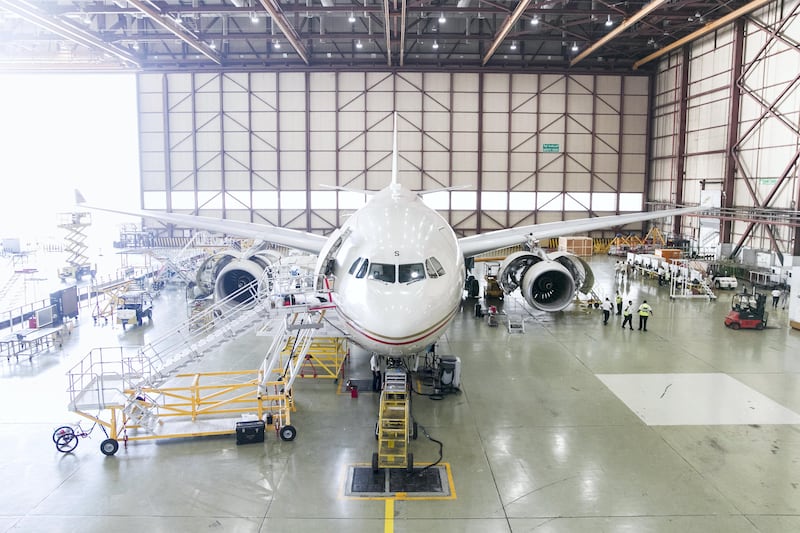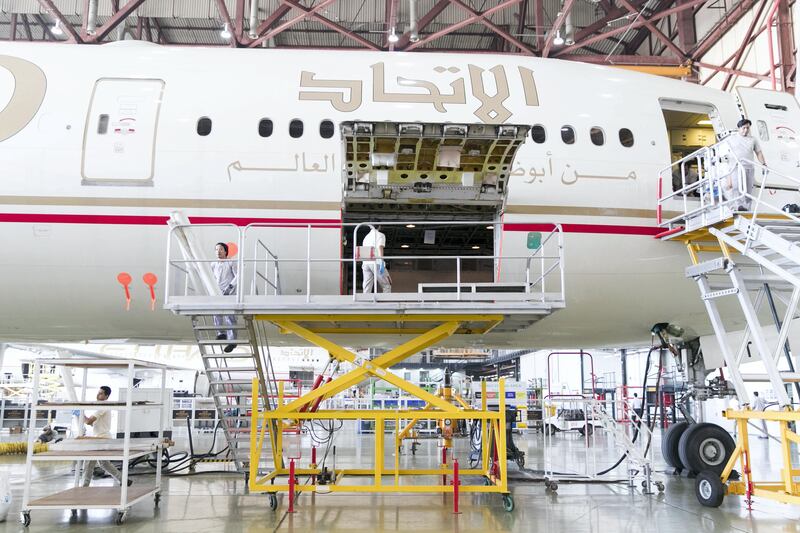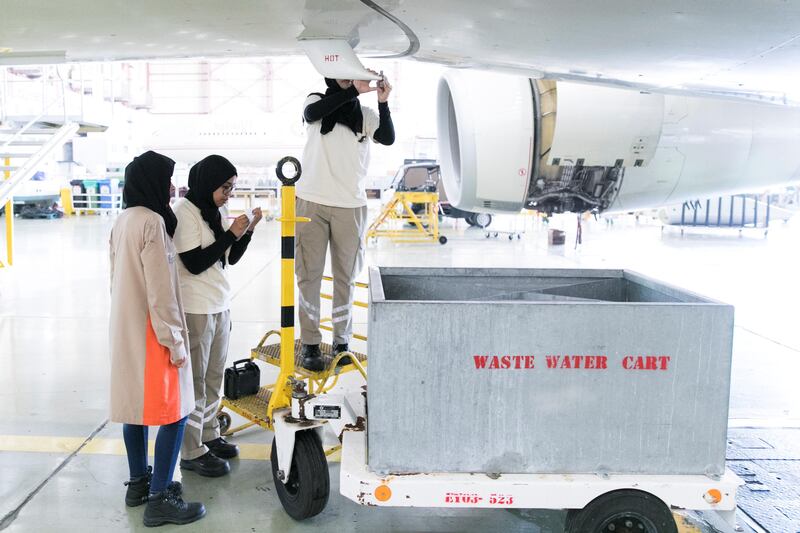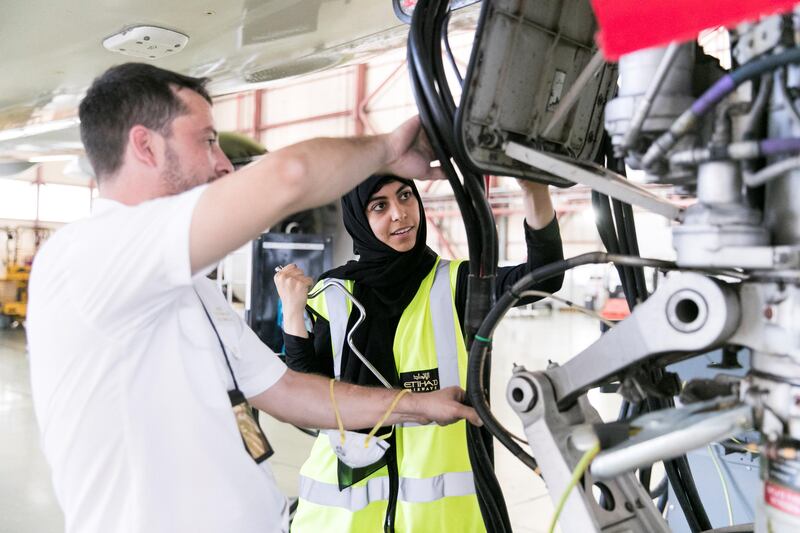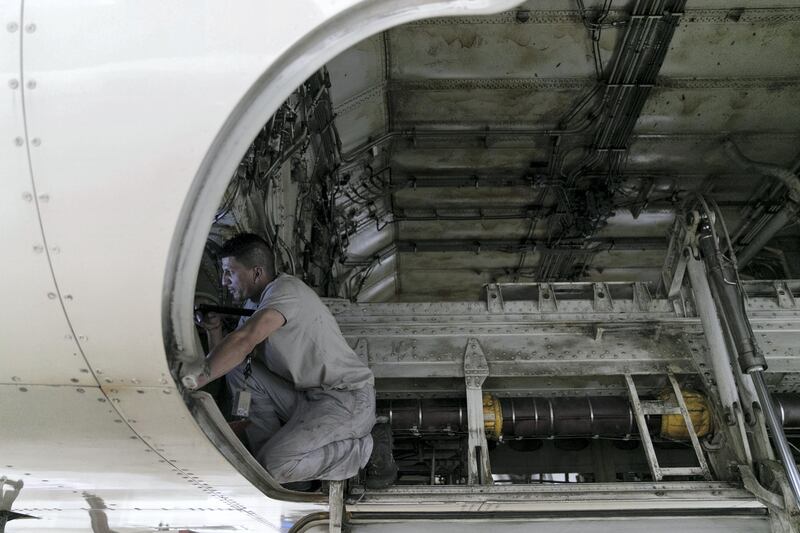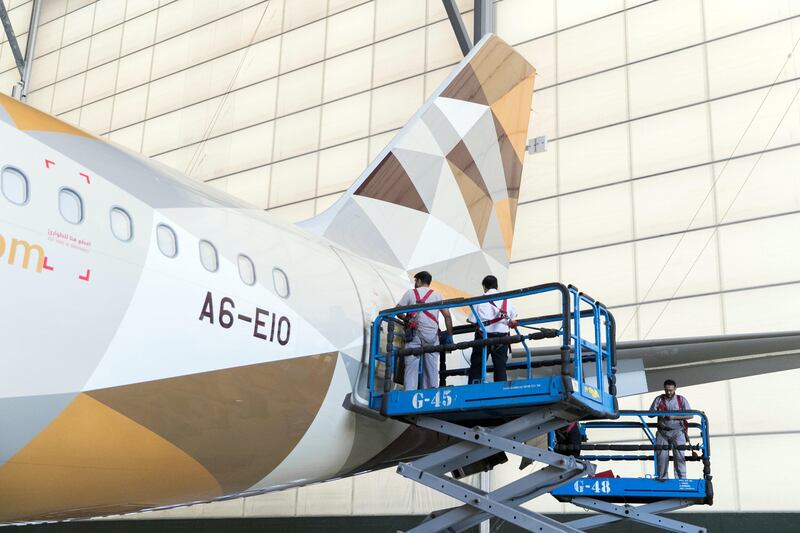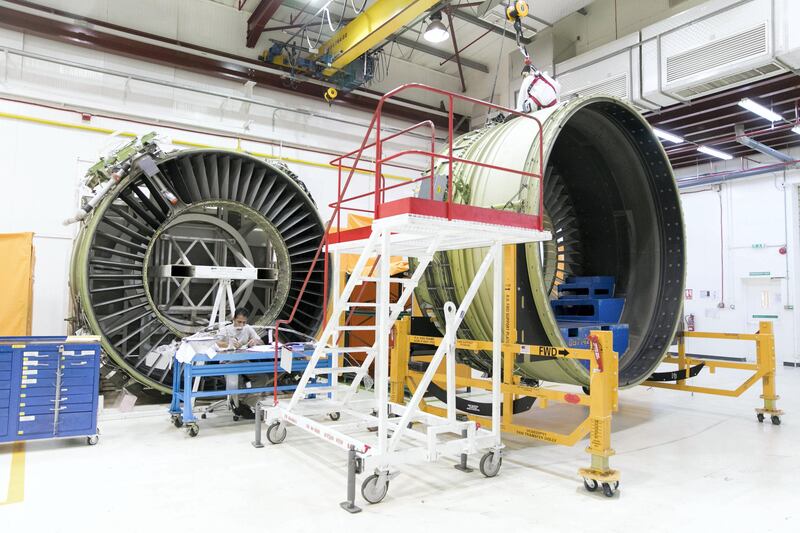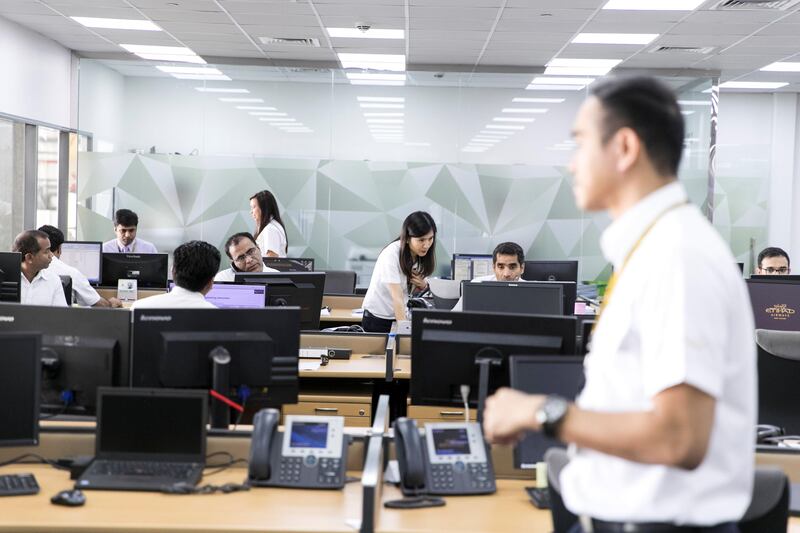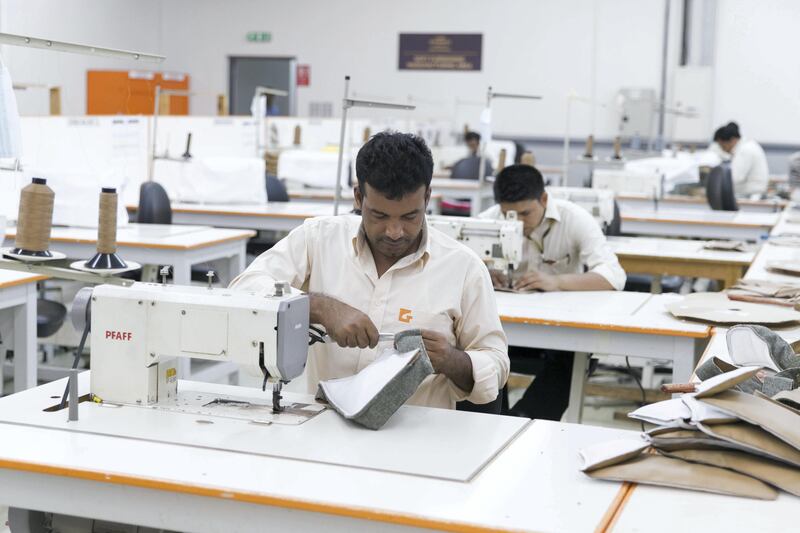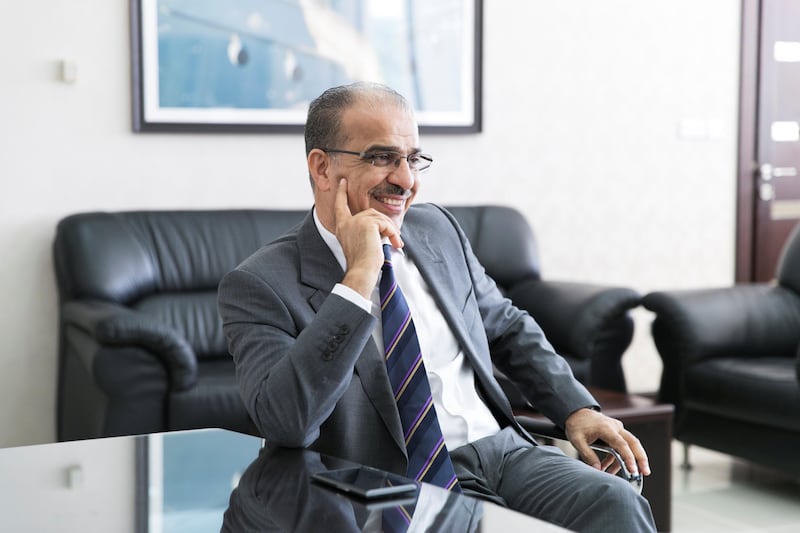Hanger six of Etihad Airways Engineering is a sight to behold. A hexagonal, pristine, cavernous space. Abu Dhabi International airport’s runway is within sight of the open doors but the Etihad Airways Engineering facility is almost a hidden treasure of the country’s thriving aviation sector. Yet, this is where the planes that get you to your holiday or business destination are kept flying. Behemoths of the sky fill this arena too – from wide-body Airbus A380s and Boeing 777s and on down the scale of modern commercial aircraft to the smaller, sleek jets operated by private airlines.
The aircraft come through the 200,000 square metres of apron and hangers at a rate of almost one a day, with 300 serviced per year. The facility can handle up to 15 at any one time including three special bays for the A380s – so named because of its 80 metre wingspan.
A look inside Etihad Airways Engineering's aircraft maintenance facility
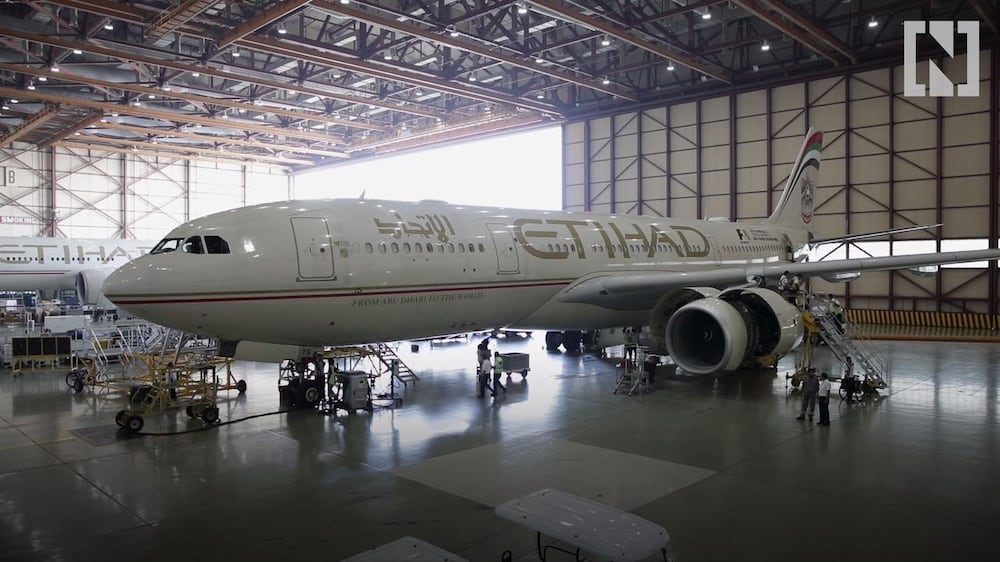
Hanger 1 is occupied with Etihad Airways operated Airbus A330 and Boeing 777 aircraft on the day I get a tour. This is where meticulous work is done to ensure your safety and comfort. It is a world class facility and it is in the heart of the UAE. On the day I visit, I can watch young Emirati engineers busy at work on an A330.
Currently, client airlines from Latin America and the private aviation sector are being given the full overhaul. Less than 30 per cent of its business comes from Etihad Airways and I am told a Lufthansa A380 is due soon, for a six year check and 65 days of maintenance, repair and overhaul. It will be stripped down to almost nothing inside as every bit of it is checked thoroughly. Only the engines are not dealt with here – another facility nearby managed by Mubadala Investment Company-owned Turbine Services & Solutions (TS&S) is where that work is carried out if they are not shipped to engine manufacturers’ facilities elsewhere in the world. Still, representatives of Rolls-Royce and GE have a permanent presence on site with Etihad Airways Engineering and each aircraft will come with its own technical liaison team from the airline.
___________
Read more:
[ Superfast internet service coming to Etihad flights ]
[ Etihad appoints new CEO for engineering unit ]
[ Lufthansa and Etihad ties deepen as repair services deal kicks off ]
___________
There is a shared history with TS&S, Etihad Airways Engineering having started life as the maintenance, repair and overhaul (MRO) firm, the Gulf Aircraft Maintenance Company (Gamco) back in the 1990s, when Abu Dhabi was still involved in Gulf Air, and later became Abu Dhabi Aircraft Technologies (Adat) in 2007 when under the auspices of Mubadala. In 2014, Etihad Airways bought its airframe, component, procurement, technical support and materials MRO business. The engine-related side remained under Mubadala and was rebranded TS&S. The current chief executive of Etihad Airways Engineering, Abdul Khaliq Saeed, took on the role in September in what was a homecoming. Mr Saeed had been with Gamco and was Adat’s chief executive until the sale to Etihad when he remained with Mubadala and ran TS&S.
“I have been part of [its story] from back in the 1990s, certainly what it was then and what it is today, it’s no comparison…This place has moved drastically, [back then] it was just one hangar and nothing else,” says Mr Saeed. “If you see what it is now with all the shops and hangers and facilities, it’s just totally different.”
A workforce of 600 has grown to 2,200 in that time, he points out.
“The changes have been big and at the same time beautiful,” he says.
It should keep growing, along with the overall industry. The global commercial air transport fleet is forecast to rise to 37,900 by 2025 from 27,114, according to 2015 data from CAPA – Centre for Aviation. Strategic consultants ICF International says that global MRO demand for the same year was US$64.3 billion – with major demand equally split between Europe, Asia-Pacific and North America. This market will grow 4.1 per cent annually to reach $96bn by 2025, driven by China and the rest of Asia-Pacific and with the Middle East expected to also show significant growth. Engines account for about 40 per cent of the market.
ST Aerospace is world’s biggest airframe MRO company at 12 million man hours, followed by HAECO at 11.7m, according to Aviation Week.
“I want to be one of the top three MROs in the world. Revenue wise we will [also] expand,” says Mr Saeed, adding that initially this will be worked toward through better efficiencies with existing capacity.
“We have a directive from our board that we should stay at 1.6 [million man hours] for this year and next year and then plan and move forward. Yes, the challenge is to move forward and we will move forward.”
In its sights are Sabena Technics and Aviation Technical Services at 2 million man hours – to break into the top ten. Lufthansa Technik is number 5 in the world at 3 million man hours.
Joost Groenenboom, principal at ICF International, says that to break into the top three will require Etihad Airways Engineering to build on its existing partnerships such as it has with Airbus and Lufthansa.
“Other MROs have been able to successfully expand by setting up joint ventures and overseas facilities to further support their customers in different regions,” says Mr Groenenboom. “This I think is also going to be a key factor for Etihad Engineering.”
Being part of the Airbus MRO Alliance, leveraging its A380 experience from working with Etihad Airways which operates the superjumbo, as well as working to join a similar programme run by Boeing leveraging its 787 experience, will also help bring in business, says Mr Saeed.
“When Boeing or Airbus are working with us, they are going to bring their customers to our facility, it is a big plus for us. It is saying these guys are good, these guys are within the same standards as them. Why not, we are trying to expand to, trying to have partnerships with these guys and many airlines we are working with now,” he says.
As part of a broader co-operation, in February the Etihad Aviation Group signed an MoU with Lufthansa Technik to explore opportunities for synergies with Etihad Airways Engineering. Last month, it won a contract to service the German carrier’s long haul fleet, leading to the arrival of the A380 at hanger six this month for its six-year check.
“We are just going to make this a wonderful experience for Lufthansa so they come back again and again.”
Keeping its workforce at the cutting edge of the industry is also key to delivering on this, particularly developing its Emirati talent.
“[This is] very important for the continuity and for the future of this business, which is going to expand and for that we need the workforce. As being part of the UAE it is our duty to train and upbring the local workforce and this is part of Abu Dhabi 2030 Vision, we are committed to deliver that.”
This focus on training also goes hand in hand with the need for quality to be upper most in people’s minds at all times given the importance of safety in the aviation business.
Beyond the aircraft themselves, an area identified for growth has been inside in the cabin. Etihad Airways Engineering has the approval of the European regulator, as well as in the UAE, to make major and minor design changes to interiors and for the manufacture of cabin parts. It also has extensive workshops for the intricate sewing, leather work and seat building needed for interiors.
“What we have found out is the area [of design] actually lacks that specific quality and experience and we went into that, we developed, we invested and at the same time we have a team who can actually deliver that. What it does, it actually puts us in a stronger place to get business in while we can actually design certain parts of the cabin for our customer. So it just gives them more flexibility when they come in here, we can do more for them,” says Mr Saeed.
This investment will also help it meet both the challenge and opportunity coming from the rising number of next generation aircraft in operation such as the Airbus A350 and Boeing 787. The latest technology means they require significantly less maintenance – the 787 requires 47 days of hanger time over 12 years compared to the Boeing 767's 136 days. However, there will be an opportunity in the data generated by new aircraft technology and growing areas such as in-flight connectivity. Etihad Airways Engineering recently collaborated with satellite firm Yahsat and Dubai-based telco du on the development of high speed broadband services for in-flight. As a result, the spending on modifications to aircraft by airlines to incorporate on board wi-fi as well as new seats and premium economy cabins is forecast to rise. Painting will also see an increase in spending – Etihad Airways Engineering also has dedicated facilities.
What about the rise of virtual reality technology, artificial intelligence and automation across all industries? Mr Saeed is sanguine about their potential for disruption.
"I don't think that in this business we will go to that [100 per cent] level of automation. Yes, it will come up to a level but at the end of the day the human factor will be there all of the time, the human touch will be there. You need that… physical work has to happen on the aircraft. Yes, workshops, yes back shops, it will be automated to a certain level but will it be 100 per cent automated, I do not see that?"
